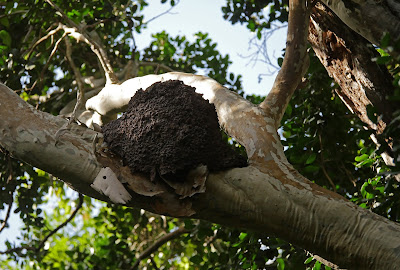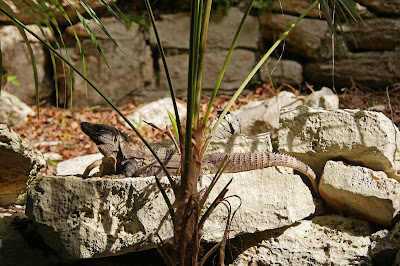A traditional Maya house
We arrived in Mexico last night and we are now en route for Mérida, stopping on the way (loosely) at the Botanical Gardens of Dr. Alfredo Barrera Marin, which were founded in 1982. My hopes of seeing some butterflies were thwarted (I saw a sole black and red one flying across a clearing), but our visit proved to be a very helpful introduction to things we would see on our trip.
The first thing we noticed (OK, our Guide, Luis, pointed out to us) was this fungus at the base of a tree.
Then we came upon a group of Ceiba (pronounced Say-ba) trees.
These are interesting for two reasons: firstly, they have savage thorns on their trunks when the trees are young. Their purpose apparently is to discourage rodents from damaging them. Secondly, the trees are sacred to the Maya people.
The great surprise for us was that the Maya, far from being just an ancient civilisation, continue to exist in large numbers in Southern Mexico and also in Guatemala, Belize, and the western portions of Honduras and El Salvador. There are thought to be about 5m people who identify themselves as Maya.
Moving on, we were delighted by the beautiful Tulipancillo flowers on a deep green bush.
Then there was the inevitable termite nest on a lower branch of a big tree - we saw lots of these on a trip to Costa Rica a few years ago.
Now we came to something unexpected: a typical Mayan house. The exterior view is at the head of this post and the interior is shown below.
Wooden posts form a square with thinner posts creating the walls, rounded at the ends to reduce wind resistance. The roof is made of palm fronds. All very interesting. But what was really surprising was that many Mayan people still live in houses like this, with the walls made wind- and waterproof with mud plaster. Later on our travels we would see see lots of similar house, some clustered in Mayan villages.
Coming into a clearing we were surprised by this succulent which seemed to be zooming up a tall tree.
Now we came to our first Mayan ruin. We would see lots of these in various states of restoration during our trip. The major sites will be covered in separate posts.
And finally, we were delighted to see our first Iguana of the trip. It was not as massive as some we saw in Costs Rica, but they are still fascinating creatures.
Conditions: hot and sunny.
Distance: negligible.
Rating: four stars. A gentle, but very interesting and valuable, scene setting.










No comments:
Post a Comment